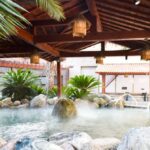Chicheng Mountain, also known as Shao Mountain, is a solitary hill that remains after the erosion of water-formed rocks. Named for its red color and the array of stone screens resembling a city wall, it is the only Danxia landform in Tiantai Mountain. During sunrise or sunset, clouds encircle the mountain’s waist, and the radiance of the setting sun envelops it, creating a dazzling spectacle. Cao Wenhui, a native of the Yuan Dynasty, described it as: ‘The rosy clouds rise from Chicheng, casting a ten-thousand-foot red light against the blue sky. A beauty does not roll her brocade, while an immortal pours out cinnabar from his ladle.’ Hence, it is known as ‘Chicheng at Sunset Glow,’ which is also one of the eight scenic views of Tiantai.
Chicheng Mountain is a sacred site for both immortals and Buddhas, with the hometown of the living Buddha Jigong and a collection of stories about famous people. It features the Yujing Cave, the sixth Taoist cave, Jigong Buddhist Courtyard, Liangfei Pagoda, and Chicheng at Sunset Glow among other landscapes. To the southeast of the mountain, where the sunlight is gentle, there are eighteen caves. Among them, Yujing, Ziyun, Canxia, Huayang, and Ruixia caves have had structures since the Tang and Song dynasties. Ziyun Cave, located on the mountain’s waist, is commonly known as Xia Yan. The top of the cave is inscribed with ‘Chicheng at Sunset Glow’ in regular script, which dates back to the Wanli period of the Ming Dynasty. Inside the cave, several rock buildings are constructed against the rock, and a stele in front of the cave reads ‘The place where Emperor Jianwen spent his years.’ Next to the cave, there is a small cave, which was originally the meditation place of the Dunhuang monk Tan Yu. Monk Huiming sculpted a reclining Buddha here during the Jianyuan period, called ‘Reclining Buddha Rock.’ The middle layer of Chicheng Mountain is the Jigong Courtyard, divided into eastern and western courtyards. The Jigong Eastern Courtyard was built in 1996 to commemorate the Buddhist Zen Master Jigong. It is built against the mountain, with two floors and four rooms, 14.5 meters high, and a construction area of 410 square meters. Inside the courtyard, there is a Jigong Hundred States Hall. The hall contains three sandalwood carvings of Jigong Buddha and seventy-nine small copper statues of Jigong on both sides. There are also eighteen different postures of Jigong statues on the corridors, with various expressions such as joy, anger, sorrow, happiness, sadness, and worry. Opening hours are from 08:00 to 16:00 all year round. Preferential policies: Children: those who are 1.2 meters (inclusive) or shorter enter for free. Children, students, and the elderly: those who are between 1.2 meters (exclusive) and 1.5 meters (inclusive) in height, full-time undergraduate students (inclusive) and below with their student ID, and people aged 60 years old (inclusive) and above with their ID card, enjoy half-price admission. Military personnel: with a valid military ID, enter for free. Disabled persons: with a valid disability certificate, enter for free. Blood donors, teachers, and talents: with a Zhejiang Province blood donation honor certificate, a 30-year teaching honor certificate, and a Taizhou City talent service card, enter for free. Additional information: The above information is for reference only, and the actual situation is subject to the disclosure of the scenic area.Chicheng Mountain
Chicheng Mountain, also known as Shao Mountain, is a solitary hill that remains after the erosion of[...]









